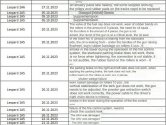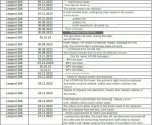Could someone post the table here? it seems i have been blocked by this accountThis is a different plant, I think, further north than Azovstal, so that could explain why it could be restarted as the fight focused in other areas.
Alleged leaked document of issues and damages reported by the Ukranians on several Leopard 1 and 2 tanks
You are using an out of date browser. It may not display this or other websites correctly.
You should upgrade or use an alternative browser.
You should upgrade or use an alternative browser.
The War in the Ukraine
- Thread starter SampanViking
- Start date
As a question of honest interest, what does Zaluzhny bring to the table given his lack of real success if Zelensky is removed somehow. For some reason, if Zaluzhny has actually succeed somewhere, I would honestly like to be informed since in reality, I honestly couldn’t think of any situation where he has honestly succeeded in well anything
As a question of honest interest, what does Zaluzhny bring to the table given his lack of real success if Zelensky is removed somehow. For some reason, if Zaluzhny has actually succeed somewhere, I would honestly like to be informed since in reality, I honestly couldn’t think of any situation where he has honestly succeeded in well anything
Supposedly, the succesful offensives in Kharkiv and Kherson were his brainchild, hence why he is popular.
According to armyrecognition, Russia can produce between 100 to 150 tanks per month
100 - 150 is probably the number of tanks disabled from damage and wear on the front per month. WIth the stockpiles they have to refurbish and return of damaged units, it can go nearly forever...Supposedly, the succesful offensives in Kharkiv and Kherson were his brainchild, hence why he is popular.
According to armyrecognition, Russia can produce between 100 to 150 tanks per month
Lone Ukrainian T-64BV tank assaulting this trench line gets knocked out by FPV drones.
RBK-500 cluster bomb with UMPC used in Novomikhailovka on Ukrainian positions.
Ukrainian leftovers in Marinka trying to hide in what's ever is left that can be used as a shelter but is attacked by FPV drones.
Battles around Artemovosk. 6th Brigade bombarding Ukrainian fortifications. Note that the ammunition cap is lifted on this area, you can use a single FPV drone or a single artillery shell to target even individuals.
Business Insider: Ukraine says Russia has it outgunned 7 to 1 in drones.
Russians pushed back from Copani to Rabotino, taking up the space there.
Russian Hawks detachment from the 33rd Regiment hits Ukrainian dugouts with FPV drones towards Novomikhailovka.
A piece of a Baba Yaga drone that was shot down.
Multiple MiG-31K reported firing Kinzhals towards the Starokonstantinov where the Su-24Ms with Storm Shadows are based.
Ukrainian observation post on top of a house gets destroyed.
Ukrainian DRG gets directly hit while observed in night vision.
Ukrainian tank gets attacked by FPV drone.
BMD-4M in action around Artemovosk. The vehicle is popular with the VDV.
Russian troops extract a downed Ukrainian UAV.
Russian tank clearing out Ukrainian left overs in Marinka.
Russian T-80BVM tank working on Belgorovka.
RBK-500 cluster bomb with UMPC used in Novomikhailovka on Ukrainian positions.
Ukrainian leftovers in Marinka trying to hide in what's ever is left that can be used as a shelter but is attacked by FPV drones.
Battles around Artemovosk. 6th Brigade bombarding Ukrainian fortifications. Note that the ammunition cap is lifted on this area, you can use a single FPV drone or a single artillery shell to target even individuals.
Business Insider: Ukraine says Russia has it outgunned 7 to 1 in drones.
Russians pushed back from Copani to Rabotino, taking up the space there.
Russian Hawks detachment from the 33rd Regiment hits Ukrainian dugouts with FPV drones towards Novomikhailovka.
A piece of a Baba Yaga drone that was shot down.
Multiple MiG-31K reported firing Kinzhals towards the Starokonstantinov where the Su-24Ms with Storm Shadows are based.
Ukrainian observation post on top of a house gets destroyed.
Ukrainian DRG gets directly hit while observed in night vision.
Ukrainian tank gets attacked by FPV drone.
BMD-4M in action around Artemovosk. The vehicle is popular with the VDV.
Russian troops extract a downed Ukrainian UAV.
Russian tank clearing out Ukrainian left overs in Marinka.
Russian T-80BVM tank working on Belgorovka.
Last edited:
According to armyrecognition, Russia can produce between 100 to 150 tanks per month
Jesus Functional Illiteracy Christ!
Direct quotation from the article:
"In 2023, despite economic and technological challenges, the Russian military industry significantly increased its tank production. According to claims by Viktor Murakhovsky, a Russian military expert, the country's defense industry supplied the Russian army with about 2,100 tanks of various types, ranging from older models T-54/55 and T-62 to the latest T-90M Proryv. This increase is significant compared to previous data, which suggested an annual production of about 200 new tanks, specifically of the T-90M Proryv type. In 2023, the Russian army received 210 new tanks, compared to only 30 units in 2020, and the number of T-72B3 tanks delivered in 2023 is 840 vehicles, compared to 120 units in 2020.
To address various problems, Russia also decided to restart the production of the T-80 combat tank, a Soviet-era model, mainly due to its performance in the ongoing conflict in Ukraine. [...]"
The article cites no figures for production of tanks, apart from one vague mention of "previous data" which "suggests" annual production. It only cites figures for deliveries to the armed forces which includes active vehicles repaired in factories and returned to service and vehicles reactivated from reserve stock.
The estimated number of T-62M available in reserve for reactivation is ~850 tanks.
Similarly the number of T-80s and T-72s in reserve, estimated as available for reactivation within 6-12 months, depending on availability of necessary parts and production capacity, is 1500 to 3000.
Note that this number indicates only the estimated number of tanks available for reactivation within a given time period, not the actual capacity of the industry to restore such number in that time period. The proper way to understand it is that Russia has up to 3000 T-80 in condition allowing return to service within 6-12 months but how many will be returned depends on other factors including availability of spares and production.
from report by Institute Action Resilience:
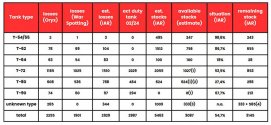
As for repairs:

The primary maintenance problem for tanks is mobility, not fire.
Assuming T-80 engages in combat maneuvers for 1h with avg speed of 20km/h (20m @ 40km/h + 20m @ 20km/h + 20m @ 0km/h) TO-1 is required after 120h 125h and medium repair after 500h of maneuvers. Assuming notional combat per day at 6h of maneuvers which requires TO-1 after 20 days and medium repair after 80 days and total repair after 165 days.
While it is possible to reduce use of assets to slow down the wear Russia used its tanks aggressively in the first three months of the war and then at somewhat reduced tempo for the next six months. When the winter offensive began the use of armor dropped markedly because that was the time when most of the fleet required factory repair which meant that combined with earlier losses (~1600 tanks by 30/12/22 per Oryx) there weren't enough tanks operational to conduct larger armoured operations. Excessive wear is also the reason why such large numbers of tanks were lost in early months of the war (~530 lost by 7/4/22) and then why losses increased during Kharkiv and Kherson operations . Many of these vehicles lost were vehicles already non-operational due to Russia's inability to maintain them far in the field at necessary rates hence high abandonment/capture rates. Those losses were back-filled with immediate reserves (approx ~30% active vehicles) which then were wore down by continuing fighting over the summer/fall.
Too many tanks moving too much over too long. There hasn't been an armoured conflict of this scale, intensity and duration since WW2.
This is annual production capacity estimate:
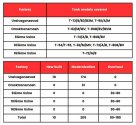
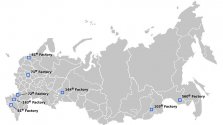
400 vehicles overhauled/modernised during peacetime can be plausibly doubled at wartime mobilisation of industry, even if it is limited mobilisation. Coupled with reactivation of immediate reserves which amount to approx 1200 tanks of all types that should match the 2100 vehicles delivered in 2023 with effort combined from 2023 and 2022.
No country in the world has the ability to manufacture new tanks at 200+ vehicles per year and support total force of ~3000 tanks in the field with regular repairs and restore reserves to backfill high losses of 500-1500 vehicles.
Russia was only able to do it because it has been preparing for war since since 2004 Ukrainian election and actively building stockpiles since 2010.
Timeline of deliveries - note that orders had to be made earlier and spot 2014 on the graph:

They were able to field 3000 tanks because they had 3000 more tanks ready in reserve. What they didn't expect is the catastrophic failure of the operational plan.
With the current rate of losses - 2500 mbt, 4500 ifv/apc, 850 arty (+ multiple barrel changes) - there simply won't be enough resources for the next one because as I already showed war requires reserves to retain combat readiness. Otherwise mechanised units are mechanised in name only.
The T-72B3s were built like this: T-72Bs in service were given basic repairs and were sent to reserve while unused T-72Bs from reserve were upgraded. Life of modernised tanks was extended at lower price but at the cost of shorter lifespan of the reserve tanks. Now those reserve tanks are being returned to service due to high losses - ~300 (of 600) T-72B3M, ~350 (of 850) T-72B3, ~500 (of?) T-72B - but they won't last as long as the upgraded ones... because they weren't repaired fully. Similar cost-cutting solution was applied to T-80s. All to boost total tank numbers ASAP.
It's even worse for IFVs - by active service in 2/22 losses are: 45% BMP-3, 33% BMP-2, 33% BTR-82A, 20% MT-LB. All active 500 BMP-1 have been lost and reserve stockpile is already used in high hundreds to backfill other losses. E.g. the total stockpile of BMP-2s isn't enough to return to 2/22 active numbers for that vehicle. Both BMP-3 and BMP-2 will be augmented by BMP-1. While number of tanks allowed for 1:1 active-reserve balance Russia never had enough IFVs and those that they had were of poor quality. BMP-3 are not great. BMP-2 are awful. BMP-1 are de facto apcs, and bad ones.
The army has also been significantly expanded since Dec 2022 and new units have nominally motor rifle status so they need vehicles. So far they receive old tanks (T-55, T-62) and symbolic numbers of BMP-1s. So they're rifles, just without their motors.
Losses of RU vehicles in 2023 (mostly static front) and speculative for 2024 without additional production and without army expansion in Dec/22:
| type | T-90 | T-72 (all) | T-80 | BMP-3 | BMP-2 | BMP-1 | BTR-82A | MT-LB |
| losses by 12/2022 | 35 | 805 | 365 | 205 | 685 | 260 | 375 | 535 |
| losses by 12/2023 | 95 | 1310 | 685 | 335 | 1115 | 615 | 585 | 825 |
| diff. | 60 | 505 | 320 | 130 | 430 | 355 | 210 | 290 |
| 12/2024 ? | 155 | 1815 | 1005 | 465 | 1545 | 970 | 795 | 1115 |
| total active + res 2/2022 | 420 | 4280 | 1080 | 760? | 4500 | 7000? | 1850 | 3800+ |
| total by 12/24 | 265 | 2465 | 75 | 295 | 2955 | ? | 1055 | ? |
| active on 2/22 | 420 | 2150 | 550 | 760 | 3400 | 500 | 1850 | 3800 |
| deficit vs 2/22 | 155 | 315 | 475 | 465 | 445 | ? | 845 | ? |
tank deficit: 945+
ifv deficit: 1755+
apc deficit: ?
There are likely enough BMP-1 and MT-LB to fill the ifv/apc deficits but not tanks. And there is nothing left for reserves. We're back to WW1 quality.
And that's if Ukraine collapses so that Russia can withdraw some of its army from there by after 12/24. If the conflict continues then Russia has nothing. Except nukes and desperate prayers for something to happen that will draw attention away from it e.g. another Palestine.
Last edited:
It is clear Russia cannot sustain high tempo operation forever, but they don't have to. If Ukraine + western aid run low on equipments, Russian loss will go down, and vice versa. So the question then becomes who is running low first? The war is a race between NATO and Russian war economy. Russia is betting on reduced attrition on vehicle once western aid dwindles.Jesus Functional Illiteracy Christ!
Direct quotation from the article:
"In 2023, despite economic and technological challenges, the Russian military industry significantly increased its tank production. According to claims by Viktor Murakhovsky, a Russian military expert, the country's defense industry supplied the Russian army with about 2,100 tanks of various types, ranging from older models T-54/55 and T-62 to the latest T-90M Proryv. This increase is significant compared to previous data, which suggested an annual production of about 200 new tanks, specifically of the T-90M Proryv type. In 2023, the Russian army received 210 new tanks, compared to only 30 units in 2020, and the number of T-72B3 tanks delivered in 2023 is 840 vehicles, compared to 120 units in 2020.
To address various problems, Russia also decided to restart the production of the T-80 combat tank, a Soviet-era model, mainly due to its performance in the ongoing conflict in Ukraine. [...]"
The article cites no figures for production of tanks, apart from one vague mention of "previous data" which "suggests" annual production. It only cites figures for deliveries to the armed forces which includes active vehicles repaired in factories and returned to service and vehicles reactivated from reserve stock.
The estimated number of T-62M available in reserve for reactivation is ~850 tanks.
Similarly the number of T-80s and T-72s in reserve, estimated as available for reactivation within 6-12 months, depending on availability of necessary parts and production capacity, is 1500 to 3000.
Note that this number indicates only the estimated number of tanks available for reactivation within a given time period, not the actual capacity of the industry to restore such number in that time period. The proper way to understand it is that Russia has up to 3000 T-80 in condition allowing return to service within 6-12 months but how many will be returned depends on other factors including availability of spares and production.
from report by Institute Action Resilience:
View attachment 122631
As for repairs:
View attachment 122630
The primary maintenance problem for tanks is mobility, not fire.
Assuming T-80 engages in combat maneuvers for 1h with avg speed of 20km/h (20m @ 40km/h + 20m @ 20km/h + 20m @ 0km/h) TO-1 is required after 120h 125h and medium repair after 500h of maneuvers. Assuming notional combat per day at 6h of maneuvers which requires TO-1 after 20 days and medium repair after 80 days and total repair after 165 days.
While it is possible to reduce use of assets to slow down the wear Russia used its tanks aggressively in the first three months of the war and then at somewhat reduced tempo for the next six months. When the winter offensive began the use of armor dropped markedly because that was the time when most of the fleet required factory repair which meant that combined with earlier losses (~1600 tanks by 30/12/22 per Oryx) there weren't enough tanks operational to conduct larger armoured operations. Excessive wear is also the reason why such large numbers of tanks were lost in early months of the war (~530 lost by 7/4/22) and then why losses increased during Kharkiv and Kherson operations . Many of these vehicles lost were vehicles already non-operational due to Russia's inability to maintain them far in the field at necessary rates hence high abandonment/capture rates. Those losses were back-filled with immediate reserves (approx ~30% active vehicles) which then were wore down by continuing fighting over the summer/fall.
Too many tanks moving too much over too long. There hasn't been an armoured conflict of this scale, intensity and duration since WW2.
This is annual production capacity estimate:
View attachment 122632
View attachment 122633
400 vehicles overhauled/modernised during peacetime can be plausibly doubled at wartime mobilisation of industry, even if it is limited mobilisation. Coupled with reactivation of immediate reserves which amount to approx 1200 tanks of all types that should match the 2100 vehicles delivered in 2023 with effort combined from 2023 and 2022.
No country in the world has the ability to manufacture new tanks at 200+ vehicles per year and support total force of ~3000 tanks in the field with regular repairs and restore reserves to backfill high losses of 500-1500 vehicles.
Russia was only able to do it because it has been preparing for war since since 2004 Ukrainian election and actively building stockpiles since 2010.
Timeline of deliveries - note that orders had to be made earlier and spot 2014 on the graph:
View attachment 122634
They were able to field 3000 tanks because they had 3000 more tanks ready in reserve. What they didn't expect is the catastrophic failure of the operational plan.
With the current rate of losses - 2500 mbt, 4500 ifv/apc, 850 arty (+ multiple barrel changes) - there simply won't be enough resources for the next one because as I already showed war requires reserves to retain combat readiness. Otherwise mechanised units are mechanised in name only.
The T-72B3s were built like this: T-72Bs in service were given basic repairs and were sent to reserve while unused T-72Bs from reserve were upgraded. Life of modernised tanks was extended at lower price but at the cost of shorter lifespan of the reserve tanks. Now those reserve tanks are being returned to service due to high losses - ~300 (of 600) T-72B3M, ~350 (of 850) T-72B3, ~500 (of?) T-72B - but they won't last as long as the upgraded ones... because they weren't repaired fully. Similar cost-cutting solution was applied to T-80s. All to boost total tank numbers ASAP.
It's even worse for IFVs - by active service in 2/22 losses are: 45% BMP-3, 33% BMP-2, 33% BTR-82A, 20% MT-LB. All active 500 BMP-1 have been lost and reserve stockpile is already used in high hundreds to backfill other losses. E.g. the total stockpile of BMP-2s isn't enough to return to 2/22 active numbers for that vehicle. Both BMP-3 and BMP-2 will be augmented by BMP-1. While number of tanks allowed for 1:1 active-reserve balance Russia never had enough IFVs and those that they had were of poor quality. BMP-3 are not great. BMP-2 are awful. BMP-1 are de facto apcs, and bad ones.
The army has also been significantly expanded since Dec 2022 and new units have nominally motor rifle status so they need vehicles. So far they receive old tanks (T-55, T-62) and symbolic numbers of BMP-1s. So they're rifles, just without their motors.
Losses of RU vehicles in 2023 (mostly static front) and speculative for 2024 without additional production and without army expansion in Dec/22:
type T-90 T-72 (all) T-80 BMP-3 BMP-2 BMP-1 BTR-82A MT-LB losses by 12/2022 35 805 365 205 685 260 375 535 losses by 12/2023 95 1310 685 335 1115 615 585 825 diff. 60 505 320 130 430 355 210 290 12/2024 ? 155 1815 1005 465 1545 970 795 1115 total active + res 2/2022 420 4280 1080 760? 4500 7000? 1850 3800+ total by 12/24 265 2465 75 295 2955 ? 1055 ? active on 2/22 420 2150 550 760 3400 500 1850 3800 deficit vs 2/22 155 315 475 465 445 ? 845 ?
tank deficit: 945+
ifv deficit: 1755+
apc deficit: ?
There are likely enough BMP-1 and MT-LB to fill the ifv/apc deficits but not tanks. And there is nothing left for reserves. We're back to WW1 quality.
And that's if Ukraine collapses so that Russia can withdraw some of its army from there by after 12/24. If the conflict continues then Russia has nothing. Except nukes and desperate prayers for something to happen that will draw attention away from it e.g. another Palestine.

